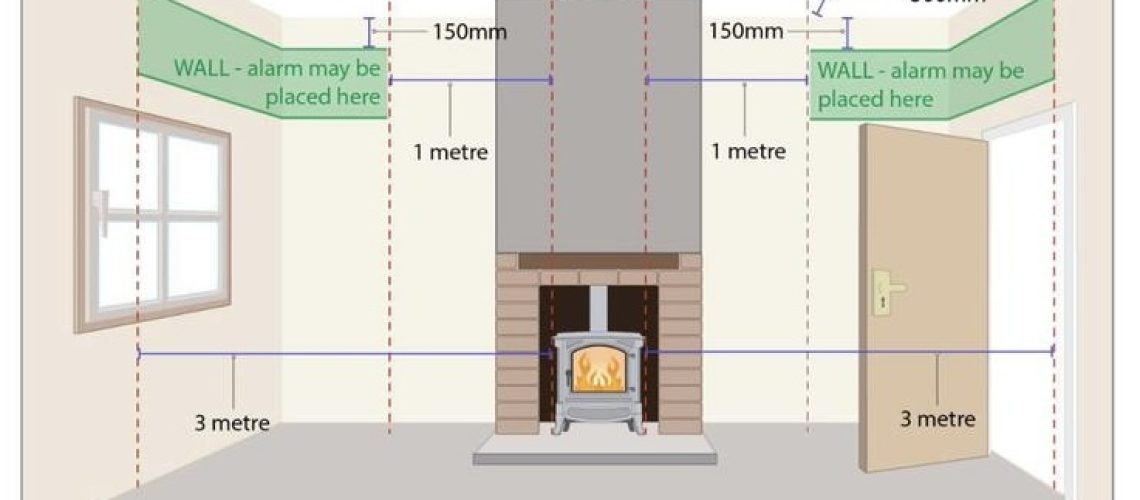Carbon Monoxide (CO) is nasty stuff. Every gas appliance can produce carbon monoxide. Regular servicing and maintenance of appliances reduce the risk of carbon monoxide. This blog looks at the importance of a CO alarm position near a fireplace.
One key element in the event of CO incident is how the appliance sources air to burn the fuel. A room-sealed appliance, such as a wall-mounted gas boiler, mixes air from outside to burn gas. The source of air is clear and constant and has a sealed combustion chamber away from the room. This type of appliance is relatively low risk.
An open flued appliance, like a fire in a fireplace, requires air from the room to burn the fuel safely. There must be enough air available in the room when using the appliance to ensure it burns the fuel correctly. Failure to do so can lead to incomplete combustion, and the creation of carbon monoxide.
Dangers of CO
CO is a killer. A tiny build-up of CO in a confined space is lethal. A CO alarm is essential for all spaces occupied by people or animals where there is a risk of CO. In the next paragraph, we explain how deadly carbon monoxide is.
The health effects of CO depend on the CO concentration and length of exposure, as well as each individual’s health condition. They measure CO concentration in parts per million (ppm). Most people will not experience any symptoms from prolonged exposure to CO levels of approximately 1 to 70 ppm but some heart patients might experience an increase in chest pain. As CO levels increase and remain above 70 ppm, symptoms become more noticeable and can include headache, fatigue and nausea. At sustained CO concentrations above 150 to 200 ppm, disorientation, unconsciousness, and death are possible. If the build-up of CO reached levels of 1% total in the enclosed space, this would kill anyone within 5 minutes.
ALWAYS SEEK MEDICAL ADVICE IF YOU THINK YOU OR SOMEONE ELSE HAS EXPOSURE TO CARBON MONOXIDE.
>>> Check out more information from this video <<<
Flue and Ventilation Checks
To reduce the risk of CO forming in rooms containing fires, we install additional ventilation where required. We conduct many tests to confirm that flues and chimneys are safe, and pull all products of combustion clear of the room. If these tests fail, a competent qualified person must carry out further inspection and modification of the flue. They must also inspect air sources and install additional ventilation where required. Once the flue and ventilation pass, it is essential that they fit a CO alarm.
Position of alarm
A fire inspection once a year ensures everything works safely. Anything can happen from one inspection to another, from adverse weather to failure of components. A CO alarm acts as a warning long before there is an issue to life in the property. So, where is the best CO alarm position near a fireplace?
The key factors to consider are the effects of air in the room, and the characteristics of the fire when in use.
First let’s look at the room.
It is important that homes circulate air. This prevents the build-up of damp and condensation and also helps move unwanted odours and germ particles away. The CO alarm needs to monitor a stable flow of air through the room. Too close to a door or openable window can clear the CO sensor from detecting the chemical. A position with adequate space away from a sudden change in air will provide accurate CO readings. Airflow can also come through the chimney and back into the room. A down-draught from high winds can cause a temporary production of CO, as it blows the products of combustion back into the fire. A CO alarm position too close to the fire could trigger the alarm in such circumstances.
Second is the fire
It will produce CO if there is incomplete combustion. CO will enter the room towards the ceiling first. The reason is the chemical leaves the fire hot, and heat rises so will build up at the top of the room. We do not advise a position low down as the dangerous levels could half fill the room, from the top downwards. Thus, the CO alarm position wouldn’t sound the alarm. A siting on the ceiling or the top part of the room is ideal. However, there is an exception to this positioning in the next paragraph.
A position up high is correct, but we must avoid areas of the room where dust and dirt particles may form. In the corners and edges of the room and ceiling we avoid to protect the alarm sensor. It is always best to refer to the CO Alarm manufacturer and the fire installation manual for clear guidance for the siting of your CO alarm.
If you would like help with a new or existing solid fuel or gas fire, please get in touch

